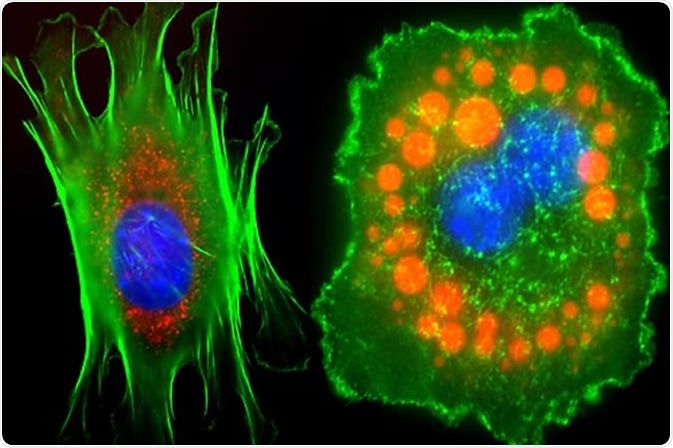Skip to:
Lipidomics is the study of cell’s lipids and their involvement in critical biological processes. Shotgun lipidomics attempts to identify, quantify, and characterize lipids present in a cell, organ, or biological system, which can encompass many hundreds of thousands of lipids.

Globules of lipids, or body fats, cluster in a fibrous, pre-fat cell (shown in orange, left) and appear greatly expanded in a bulging mature fat cell on the right. Understanding lipid chemistry makes inroads to individualized medicine. Credit: Washington University in St. Louis
Shotgun Lipidomics
The application of shotgun lipidomics is complicated by several factors. For one, the sheer number of lipids present in systems can present an obstacle. Furthermore, lipids are often changing their structure and composition based on the life cycle, environmental conditions, and physiological disturbances, like those caused by disease.
Shotgun lipidomics is done using mass spectrometry, and can also be called directly infusion-based lipidomics. Several mass spectrometry techniques have been employed to study lipidomics, including electrospray ionization mass spectrometry (ESI-MS) and tandem MS (MS/MS). These methods have their own advantages and limitations. For example, the use of MS/MS and its double filtering process leads to significantly improved signal to noise ratio of the spectra.
Limitations of Current Shotgun Lipidomics Techniques
In tandem MS, which is often termed “classic shotgun lipidomics”, individual molecular species can be identified. However, there are three main limitations of this technique: 1) ion suppression, which affects ion formation and thereby the dynamic range and detection limits, 2) precision of detection, and 3) accuracy of quantification.
Ion suppression, in particular, may exclude some lipid classes that are present in low abundance or are less ionizable from analysis. For example, while the 95% coverage of cell lipids that can be achieved with shotgun lipidomics is high, there are still many thousands of species not detected in the remaining 5%.
In terms of precision, lipid species can overshadow each other when the isobaric or isomeric masses overlap between species. This can make identification less clear. Furthermore, some peaks in the spectrum may be artefacts generated by the ion source, and it can be difficult to separate these from true peaks in the spectrum.
Strategies to Lessen the Limitations of Shotgun Lipidomics
Ion suppression is an issue in both shotgun lipidomics and other mass spectrometry techniques, such as liquid chromatography mass spectrometry (LC-MS). It refers to the reduced efficiency of ionization that can occur as a result of other compounds being present, alterations in the matrix components, or because of large shifts in the levels of the target compound. While this is often present in shotgun lipidomics, studies have shown that shotgun lipidomics approaches are still feasible when used to quantify individual species of lipids compared to coexisting standards under set conditions.
Multi-dimensional mass spectrometry-based shotgun lipidomics are less focused on high mass accuracy, but are successful at minimizing ion suppression. It does so by the addition of a well-matched modifier, which increases the ionization response of non-polar lipids, and makes use of fragments that the instrument is most sensitive to in order to identify lipid species. Furthermore, it creates alternative derivatization techniques for moieties in lipid classes, which allows for selective improvement of ionization efficiency, and employs distinct charge properties to analyze lipid classes.
Alternatively, other mass spectrometry methods can be employed to overcome the shortcomings of conventional shotgun lipidomics approaches. For ion suppression, quadrupole time of flight (Q-TOF) and orbitrap mass spectrometers have a better duty cycle, which results in reduced baseline and noise and therefore a better signal to noise ratio of the spectra.
Another added benefit of Q-TOF and orbitrap are that neighboring peaks are less likely to interfere with each other due to the improved mass resolution and mass accuracy of Q-TOF and orbitrap spectrometers. Isobaric masses causing peaks to overlap can sometimes be better resolved by conventional high resolution tandem MS, and may sometimes require other solutions such as chromatographic fractionation and multistep lipid extraction.
Altering the mass spectrometer is a common way to improve on different limitations in shotgun lipidomics. For example, matrix-assisted laser desorption/ionization time of flight (MALDI-TOF) mass spectrometry tends to produce chaotic spectra for shotgun lipidomics when compared to ESI-MS, but has clear advantages when it comes to imaging lipid in tissue. The complicated spectra and improved imaging are due to MALDI-TOF’s sensitivity and the high number of lipid types present in tissue that are released by MALDI.
Sources
- Hu C., et al. (2019). Strategies to improve/eliminate the limitations in shotgun lipidomics. Proteomics. https://doi.org/10.1002/pmic.201900070
- Hsu F.F. (2018). Mass spectrometry-based shotgun lipidomics – a critical review from the technical point of view. Analytical and Bioanalytical Chemistry. https://doi.org/10.1007/s00216-018-1252-y
Further Reading